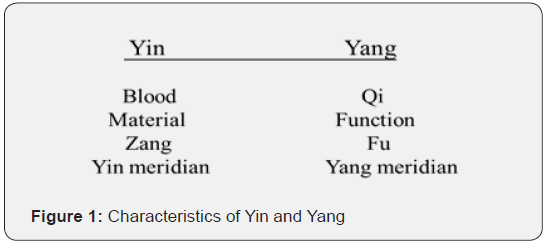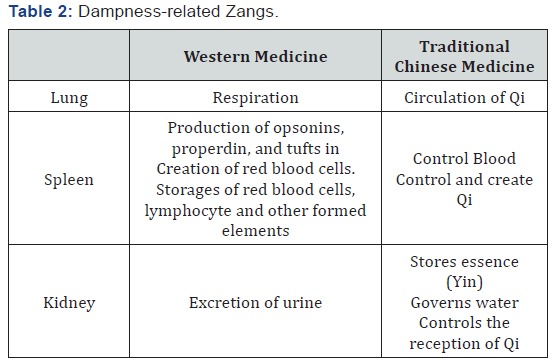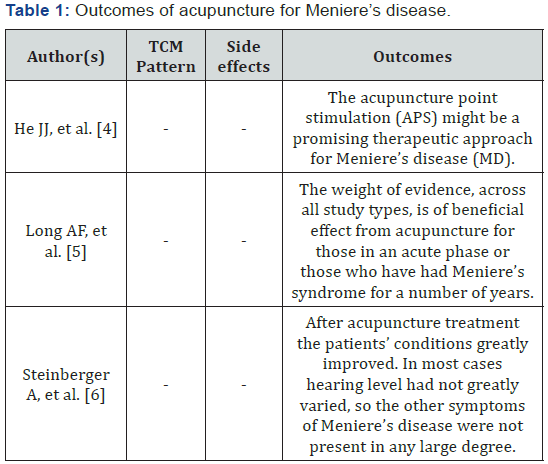Discussion
Meniere’s disease is one of the illnesses the WHO recommended in 1979 to treat with acupuncture.
Yin-Yang balance is the unique concept and one of the key principles of traditional Chinese medicine. Diseases are understood as a loss of balance between Yin and Yang as shown in Figure 1. Yin-Yang balance has been described throughout the history of Chinese medicine for many centuries and still serves as the foundation and the guide for the explanation of etiology of diseases [7].

Signs and symptoms in Traditional Chinese medicine are broader than those in Western medicine. In general TCM physicians usually do not follow typical Western pathological classifications of diseases, but rather rely on the patterns individualized by the imbalance of Yin and Yang, Qi, and Blood, and body fluids in the body. In other words, the loss of balance between Yin and Yang results in diseases. Blood (Xue) and Qi can be classified into Yin and Yang based on the TCM theory. Blood is classified into Yin and derived mainly from gu qi (food qi) that is produced by the Spleen. One of the functions of Blood is considered to be the nourishing agent. The other source that generates Blood is Kidney storing Jing (essence) that can produce marrow. Marrow then generates bone marrow contributing to manufacturing Blood. On the other hand, oxygen is equivalent to Qi to some extent. Qi, which is categorized as Yang, is viewed as a type of life-giving energy circulating throughout the body in special meridians [1]. The concepts of “Qi is the commander of Blood and Blood is the mother of Qi” highlight Qi interacts with Blood to maintain the functions of Zang-Fu organs and has been used as the guide to treat the issues of Blood and Qi [8].
In the volume of Su Wen (Essential Questions) of Huang Di Nei Jing (Essential Questions of Yellow Emperor’s Inner Classic), it is stated that “three Yang meridians of women is weaken at 42, and Kidney qi of men is deficient at 40”, which may be the invaluable guidelines to explaining why Meniere’s disease is more likely to happen to adults between 40 and 60 years of age. The key to this thought lies in Kidney that plays an important role in understanding the relationship between aging and Meniere’s disease.
The Zang-Fu theory, the Five Elements theory and patterns are unique and absolutely different from those theories of the Western medicine. In general, those who have not learned TCM are usually confused with the functions of internal organs (Zang- Fu) in the TCM. Kidney in the TCM is referred to as the “Root of Life” because it stores Essence (Jing). Essence is the creator of life and the foundation for Yin and Yang. On the other hand, the essence the Kidney stores is the foundation of producing Marrow, which is often misunderstood because it cannot exactly correspond to bone marrow in the Western medicine. Essence can be transformed into Blood, and Blood nourishes Essence. In other words, both Blood and Essence interact with each other to maintain the Yin level for normal functions in the body [9].
In the perspective of traditional Chinese medicine, abnormal fluid is defined as Dampness, which can damage the Yang of the body to stagnate fluids causing Qi stagnation Blood stasis. On the other hand, this evil is heavy, tenacious, can last for a long time and become difficult to treat, and tends to move downwards in the body. Dampness arising from Spleen qi deficiency often compromises immunity due to congestion of lymphatic system and autoimmune conditions to cause symptoms such as bloating, nausea, vomiting, heaviness of head and body, low appetite, and dizziness [7]. It is indicated that Liver and Kidney share the same origin. When Kidney functions normally, the Liver qi is able to ensure Qi to circulate consistently and smoothly in all parts of the body and not to invade Spleen.
Zangs mainly related to the etiology of Dampness include Lung, Spleen, and Kidney. Table 2 presents the differences between the functions of the Zangs in the Western medicine and the Traditional Chinese Medicine.

The most critical notion that “Feng (Wind), the beginner of the illness” is presented in Huang Di Nei Jing (Essential Questions of Yellow Emperor’s Inner Classic). In addition to Dampness, this notion pinpoints that Wind, which may be associated with vertigo and dizziness in the patients with Meniere’s disease, should be considered to be the major cause of illness with its pernicious influence and indicates that Blood mobilization and Qi regulation need to be considered simultaneously for the better results [10]. It is also stated that Blood Xu (deficiency of Blood) resulted from Blood stasis and impeded Qi generates Wind. Pain, tremor, dizziness, and spasm are the representations of Wind. Yeo et al. [11] reported that behavioral tests showed that acupuncture stimulations at GB34 and LV3 could improve the motor dysfunction like tremors and dizziness that are the representations of Wind resulted from Blood deficiency. Meniere’s disease usually affects only one ear leading to hearing difficulty or loss, which currently cannot be solved with special medical remedy well. In Huang and Li’s observation and clinical experience, it is stated APS could have good effect in controlling the vertigo and dizziness but it was not good in improving the hearing issue [12].
Fluid drainage may be the cause of the tinnitus, which is an easily negligible and terrible symptom to impact the patients’ quality of life [13]. This issue seldom draws any attentions in the present studies. Whether or not the application of acupuncture can be effect for the tinnitus has been in debate for over 40 years and has not reached a definitive conclusion [14]. In clinical literature, GV20 (Baihui) was used for the treatment of the symptoms of Meniere’s disease, including tinnitus [15].
Unfortunately, the literature reviews of this study show that patterns which play the key roles in the TCM for diagnosis and treatment were not included, and the side effects were not discussed in the previous studies.
Conclusion
Patients and health providers may take clinical effectiveness, cost effectiveness, and side effects into consideration in deciding modalities. Even though acupuncture may be insufficient to treat hearing issue, acupuncture may be more feasible for Meniere’s disease than the Western medicine with respect to time and convenience.
References
- Hong TZ (2017) Exploring a New Extra Point for Sub-acute Cough: A Case Report. Scholar’s Press, Germany.
- National Institute on Deafness and Other Communication Disorders (NIDCD). Meniere’s disease.
- Mayo Clinic. Meniere’s disease.
- He JJ, Jiang LY, Peng TQ, Xia MX, Chen H (2016) Acupuncture Points Stimulation for Meniere’s Disease/Syndrome: A Promising Therapeutic Approach. Evid Based Complement Alternat Med 2016: 6404197.
- Long AF, Xing M, Morgan K, Brettle A (2011) Exploring the Evidence Base for Acupuncture in the Treatment of Ménière’s Syndrome-A Systematic Review. Evid Based Complement Alternat Med 2011: 429102.
- Steinberger A, Pansini M (1983) The treatment of Meniere’s disease by acupuncture. Am J Chin Med 11(1-4): 102-105.
- Maciocia G (1989) The foundations of Chinese Medicine. Library of Congress Cataloging in Publication Data. NY.
- Hong TZ (2017) Exploring a New Extra Point for Subacute Cough: A Case Report. J Complement Med Alt Healthcare 3(4): 555619.
- Hong TZ (2017) Acupressure or Acupuncture at Sanyinjiao (SP6) for Primary Dysmenorrhea. J Network Med Target Ther 1(1).
- Sun P (2010) Treatment of Pain with Chinese Herbs and Acupuncture. 2011. Churchill Livingstone, NY.
- Yeo S, Choi YG, Hong YM, Lim S (2013) Neuroprotective Changes of Thalamic Degeneration-Related Gene Expression by Acupuncture in an MPTP Mouse Model of Parkinsonism: Microarray Analysis. Gene 515(2): 329-338.
- Huang N, Li C (2012) Recurrent sudden sensorineural hearing loss in a 58-year-old woman with severe dizziness: a case report. Acupunct Med 30(1): 56-59.
- Stephens D, Pyykko I, Yoshida T, et al. (2012) The consequences of tinnitus in long-standing Ménière’s disease. Auris Nasus Larynx 39(5): 469-474.
- Tassinari M, Mandrioli D, Gaggioli N, Roberti Di Sarsina P (2015) Ménière’s disease treatment: a patient-centered systematic review. Audiology and Neurotology 20(3): 153-165
- Huang Y, Chen JQ (2007) Professor OUYANG Qun’s clinical experience on application of single point. Zhongguo Zhen Jiu 27(11): 857-858.































